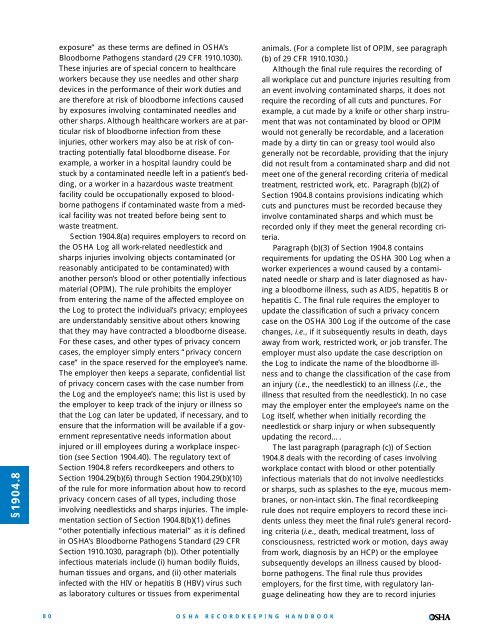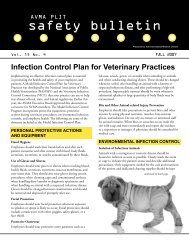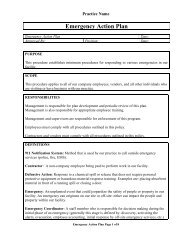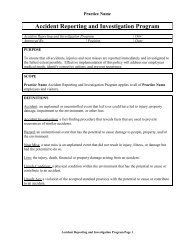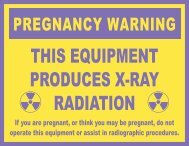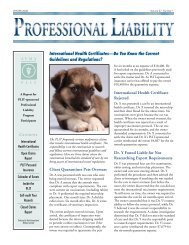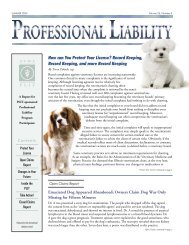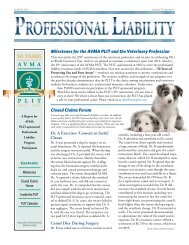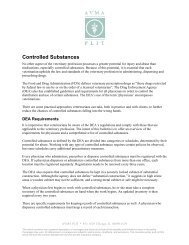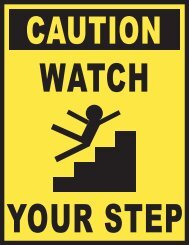§1904.8exposure” as these terms are defined in <strong>OSHA</strong>’sBloodborne Pathogens standard (29 CFR 1910.1030).These injuries are of special concern to healthcareworkers because they use needles and other sharpdevices in the performance of their work duties andare therefore at risk of bloodborne infections causedby exposures involving contaminated needles andother sharps. Although healthcare workers are at particularrisk of bloodborne infection from theseinjuries, other workers may also be at risk of contractingpotentially fatal bloodborne disease. Forexample, a worker in a hospital laundry could bestuck by a contaminated needle left in a patient’s bedding,or a worker in a hazardous waste treatmentfacility could be occupationally exposed to bloodbornepathogens if contaminated waste from a medicalfacility was not treated before being sent towaste treatment.Section 1904.8(a) requires employers to record onthe <strong>OSHA</strong> Log all work-related needlestick andsharps injuries involving objects contaminated (orreasonably anticipated to be contaminated) withanother person’s blood or other potentially infectiousmaterial (OPIM). The rule prohibits the employerfrom entering the name of the affected employee onthe Log to protect the individual’s privacy; employeesare understandably sensitive about others knowingthat they may have contracted a bloodborne disease.For these cases, and other types of privacy concerncases, the employer simply enters “privacy concerncase” in the space reserved for the employee’s name.The employer then keeps a separate, confidential listof privacy concern cases with the case number fromthe Log and the employee’s name; this list is used bythe employer to keep track of the injury or illness sothat the Log can later be updated, if necessary, and toensure that the information will be available if a governmentrepresentative needs information aboutinjured or ill employees during a workplace inspection(see Section 1904.40). The regulatory text ofSection 1904.8 refers recordkeepers and others toSection 1904.29(b)(6) through Section 1904.29(b)(10)of the rule for more information about how to recordprivacy concern cases of all types, including thoseinvolving needlesticks and sharps injuries. The implementationsection of Section 1904.8(b)(1) defines“other potentially infectious material” as it is definedin <strong>OSHA</strong>’s Bloodborne Pathogens Standard (29 CFRSection 1910.1030, paragraph (b)). Other potentiallyinfectious materials include (i) human bodily fluids,human tissues and organs, and (ii) other materialsinfected with the HIV or hepatitis B (HBV) virus suchas laboratory cultures or tissues from experimentalanimals. (For a complete list of OPIM, see paragraph(b) of 29 CFR 1910.1030.)Although the final rule requires the recording ofall workplace cut and puncture injuries resulting froman event involving contaminated sharps, it does notrequire the recording of all cuts and punctures. Forexample, a cut made by a knife or other sharp instrumentthat was not contaminated by blood or OPIMwould not generally be recordable, and a lacerationmade by a dirty tin can or greasy tool would alsogenerally not be recordable, providing that the injurydid not result from a contaminated sharp and did notmeet one of the general recording criteria of medicaltreatment, restricted work, etc. Paragraph (b)(2) ofSection 1904.8 contains provisions indicating whichcuts and punctures must be recorded because theyinvolve contaminated sharps and which must berecorded only if they meet the general recording criteria.Paragraph (b)(3) of Section 1904.8 containsrequirements for updating the <strong>OSHA</strong> 300 Log when aworker experiences a wound caused by a contaminatedneedle or sharp and is later diagnosed as havinga bloodborne illness, such as AIDS, hepatitis B orhepatitis C. The final rule requires the employer toupdate the classification of such a privacy concerncase on the <strong>OSHA</strong> 300 Log if the outcome of the casechanges, i.e., if it subsequently results in death, daysaway from work, restricted work, or job transfer. Theemployer must also update the case description onthe Log to indicate the name of the bloodborne illnessand to change the classification of the case froman injury (i.e., the needlestick) to an illness (i.e., theillness that resulted from the needlestick). In no casemay the employer enter the employee’s name on theLog itself, whether when initially recording theneedlestick or sharp injury or when subsequentlyupdating the record….The last paragraph (paragraph (c)) of Section1904.8 deals with the recording of cases involvingworkplace contact with blood or other potentiallyinfectious materials that do not involve needlesticksor sharps, such as splashes to the eye, mucous membranes,or non-intact skin. The final recordkeepingrule does not require employers to record these incidentsunless they meet the final rule’s general recordingcriteria (i.e., death, medical treatment, loss ofconsciousness, restricted work or motion, days awayfrom work, diagnosis by an HCP) or the employeesubsequently develops an illness caused by bloodbornepathogens. The final rule thus providesemployers, for the first time, with regulatory languagedelineating how they are to record injuries80<strong>OSHA</strong> RECORDKEEPINGHANDBOOK
caused by contaminated needles and other sharps,and how they are to treat other exposure incidents(as defined in the Bloodborne Pathogens standard)involving blood or OPIM. “ Contaminated” is definedjust as it is in the Bloodborne Pathogens standard:“Contaminated means the presence or the reasonablyanticipated presence of blood or other potentiallyinfectious materials on an item or surface.” …After a review of the many comments in therecord on this issue, <strong>OSHA</strong> has decided to requirethe recording of all workplace injuries from needlesticksand sharp objects that are contaminated withanother person’s blood or other potentially infectiousmaterial (OPIM) on the <strong>OSHA</strong> Log. These cases mustbe recorded, as described above, as privacy concerncases, and the employer must keep a separate list ofthe injured employees’ names to enable governmentpersonnel to track these cases…....<strong>OSHA</strong> disagrees, believing that Congress mandatedthe recording of all non-minor injuries and illnessesas well as all injuries resulting in medicaltreatment or one of the other general recording criteria.<strong>OSHA</strong> finds that needlestick and sharps injuriesinvolving blood or other potentially infectious materialsare non-minor injuries, and therefore must berecorded. This conclusion is consistent with theSenate Committee on Appropriations report accompanyingthe fiscal year 1999 Departments of Labor,Health and Human Services, and Education andRelated Agencies Appropriation Bill, 1999 (S. 2440)which included the following language:Accidental injuries from contaminated needles andother sharps jeopardize the well-being of ourNation’s health care workers and result in preventabletransmission of devastating bloodborne illnesses,including HIV, hepatitis B, and hepatitis C. The committeeis concerned that the <strong>OSHA</strong> 200 Log does notaccurately reflect the occurrence of these injuries.The committee understands that the reporting andrecordkeeping standard (29 CFR 1904) requires therecording on the <strong>OSHA</strong> 200 Log of injuries frompotentially contaminated needles and other sharpsthat result in: the recommendation or administrationof medical treatment beyond first aid; death, restrictionof work or motion; loss of consciousness, transferto another job, or seroconversion in the worker.Accidental injuries with potentially contaminatedneedles or other sharps require treatment beyondfirst aid. Therefore, the Committee urges <strong>OSHA</strong> torequire the recording on the <strong>OSHA</strong> 200 log ofinjuries from needles and other sharps potentiallycontaminated with bloodborne pathogens (SenateReport 105-300).<strong>OSHA</strong> finds that these injuries are significant injuriesbecause of the risk of seroconversion, disease, anddeath they pose (see the preamble to the <strong>OSHA</strong>Bloodborne Pathogens Standard at 56 FR 64004)….<strong>OSHA</strong> disagrees with those commenters whoargued that the Section 1904.8 recording requirementwould be duplicative or redundant with the requirementsin the Bloodborne Pathogens standard (29CFR 1910.1030). That standard requires the employerto document the route(s) of exposure and the circumstancesunder which the exposure incident occurred,but does not require that it be recorded on the Log(instead, the standard requires only that such documentationbe maintained with an employee’s medicalrecords). The standard also has no provisionsrequiring an employer to aggregate such informationso that it can be analyzed and used to correct hazardousconditions before they result in additionalexposures and/or infections. The same is true forother medical records kept by employers: they donot substitute for the <strong>OSHA</strong> Log or meet the purposesof the Log, even though they may contain informationabout a case that is also recorded on the Log.<strong>OSHA</strong> is requiring only that lacerations and puncturewounds that involve contact with another person’sblood or other potentially infectious materialsbe recorded on the Log. Exposure incidents involvingexposure of the eyes, mouth, other mucous membranesor non-intact skin to another person’s bloodor OPIM need not be recorded unless they meet oneor more of the general recording criteria, result in apositive blood test (seroconversion), or result in thediagnosis of a significant illness by a health care professional.Otherwise, these exposure incidents areconsidered only to involve exposure and not to constitutean injury or illness. In contrast, a needlesticklaceration or puncture wound is clearly an injury and,if it involves exposure to human blood or otherpotentially infectious materials, it rises to the level ofseriousness that requires recording. For splashes andother exposure incidents, the case does not rise tothis level any more than a chemical exposure does. Ifan employee who has been exposed via a splash inthe eye from the blood or OPIM of a person with abloodborne disease actually contracts an illness, orseroconverts, the case would be recorded (providedthat it meets one or more of the general recordingcriteria).Privacy Issues…The final recordkeeping rule addresses this issueby prohibiting the entry of the employee’s name onthe <strong>OSHA</strong> 300 Log for injury and illness cases involv-§1904.8<strong>OSHA</strong> RECORDKEEPINGHANDBOOK81
- Page 1 and 2:
www.osha.govOSHARecordkeepingHandbo
- Page 3 and 4:
OSHARecordkeeping HandbookThe Regul
- Page 5 and 6:
ContentsRecordkeeping HandbookRoadm
- Page 7 and 8:
Section 1904.40Providing records to
- Page 10 and 11:
§1904.0…OSHA has rejected the su
- Page 12 and 13:
§1904.1Since publication of the re
- Page 14 and 15:
§1904.2SIC code Industry descripti
- Page 16 and 17:
§1904.2tinue to have injury and il
- Page 18 and 19:
Section 1904.3Keeping records for m
- Page 20 and 21:
PREAMBLE DISCUSSION: Section 1904.4
- Page 22 and 23:
(viii)(ix)The illness is the common
- Page 24 and 25:
§1904.5employment environment. For
- Page 26 and 27:
§1904.5the employee’s status as
- Page 28 and 29:
§1904.5Exceptions Proposed but Not
- Page 30 and 31:
§1904.5pain and swelling in a join
- Page 32 and 33:
§1904.5the worker has taken a side
- Page 34 and 35:
§1904.526“Personal tasks” for
- Page 36 and 37:
If the accident had occurred in a l
- Page 38 and 39: Scenario 4:• An employee reports
- Page 40 and 41: In applying [the presumption of wor
- Page 42 and 43: Letters of interpretation related t
- Page 44 and 45: November 19, 2002Joseph Woodward, E
- Page 46 and 47: Letter of interpretation related to
- Page 48 and 49: §1904.6that the two injuries or il
- Page 50 and 51: §1904.6…Under the OSHA recordkee
- Page 52 and 53: FREQUENTLY ASKED QUESTIONS: Section
- Page 54 and 55: Since the employee was not performi
- Page 56 and 57: In each of the eight scenarios in y
- Page 58 and 59: §1904.7other licensed health care
- Page 60 and 61: §1904.7that eliminates the routine
- Page 62 and 63: §1904.7pose. This paragraph also s
- Page 64 and 65: §1904.7Counting Lost Workdays When
- Page 66 and 67: §1904.7tors to such injuries and i
- Page 68 and 69: §1904.7This list of first aid trea
- Page 70 and 71: §1904.7visit to a health care prof
- Page 72 and 73: §1904.7However, as discussed above
- Page 74 and 75: §1904.766immediate recording of si
- Page 76 and 77: §1904.7strength? How is an employe
- Page 78 and 79: §1904.7or illness. The severity of
- Page 80 and 81: The first treatment is glue used to
- Page 82 and 83: Response: The employer would have t
- Page 84 and 85: Letter of interpretation related to
- Page 86 and 87: Letter of interpretation related to
- Page 90 and 91: ing blood and other potentially inf
- Page 92 and 93: standard. In some cases employers v
- Page 94 and 95: PART 1904—[AMENDED] (67 FR 77170,
- Page 96 and 97: §1904.1088OSHA RECORDKEEPINGcorrec
- Page 98 and 99: §1904.1090OSHA RECORDKEEPINGAwaren
- Page 100 and 101: §1904.1092reasonable checks agains
- Page 102 and 103: §1904.1094determination. Second, t
- Page 104 and 105: FREQUENTLY ASKED QUESTIONS: Section
- Page 106 and 107: Also, from time to time we update o
- Page 108 and 109: §1904.11Section 1904.11Recording c
- Page 110 and 111: §1904.11of causation applies to th
- Page 112 and 113: §1904.12Thus, the total MSD count
- Page 114 and 115: §1904.12current survey was designe
- Page 116 and 117: §1904.29son’s blood or other pot
- Page 118 and 119: §1904.29cern cases, and the list m
- Page 120 and 121: §1904.29have also been designed to
- Page 122 and 123: §1904.29with that entry and employ
- Page 124 and 125: FREQUENTLY ASKED QUESTIONS: Section
- Page 126 and 127: Section 1904.29(b)(10). In addition
- Page 128 and 129: Section 1904.30Multiple business es
- Page 130 and 131: fest themselves quickly and can be
- Page 132 and 133: §1904.31The term “employee” me
- Page 134 and 135: §1904.31companies, and other tempo
- Page 136 and 137: Letter of interpretation related to
- Page 138 and 139:
Scenario 5:• An employee drives i
- Page 140 and 141:
Response: The log is to be kept for
- Page 142 and 143:
Section 1904.32Annual summary(66 FR
- Page 144 and 145:
§1904.32The company executive cert
- Page 146 and 147:
Deletions from the former rule....F
- Page 148 and 149:
I do want to make one further point
- Page 150 and 151:
sede any longer retention periods s
- Page 152 and 153:
Response: The controlling employer
- Page 154 and 155:
Section 1904.35Employee involvement
- Page 156 and 157:
§1904.351904 regulation to provide
- Page 158 and 159:
§1904.35tions on employees’ and
- Page 160 and 161:
employee, the employer must provide
- Page 162 and 163:
Thank you for your interest in occu
- Page 164 and 165:
Letter of interpretation related to
- Page 166 and 167:
Section 1904.36Prohibition against
- Page 168 and 169:
and section 1952.4 spells out the r
- Page 170 and 171:
§1904.38Section 1904.38Variances f
- Page 172 and 173:
§1904.38cited and the citation is
- Page 174 and 175:
§1904.39PREAMBLE DISCUSSION: Secti
- Page 176 and 177:
§1904.39FREQUENTLY ASKED QUESTIONS
- Page 178 and 179:
§1904.40maintains the records at a
- Page 180 and 181:
June 23, 2003Mr. Edwin G. Foulke, J
- Page 182 and 183:
Section 1904.41Annual OSHA injury a
- Page 184 and 185:
Section 1904.42Requests from the Bu
- Page 186 and 187:
Section 1904.43Summary and posting
- Page 188 and 189:
Section 1904.44Retention and updati
- Page 190 and 191:
Section 1904.45OMB control numbers
- Page 192 and 193:
allows him or her to independently
- Page 194 and 195:
§1904.46the three criteria above,
- Page 196 and 197:
§1904.46approach will provide an i
- Page 198 and 199:
FREQUENTLY ASKED QUESTIONS: Section
- Page 200 and 201:
Section 1952.4Injury and illness re


